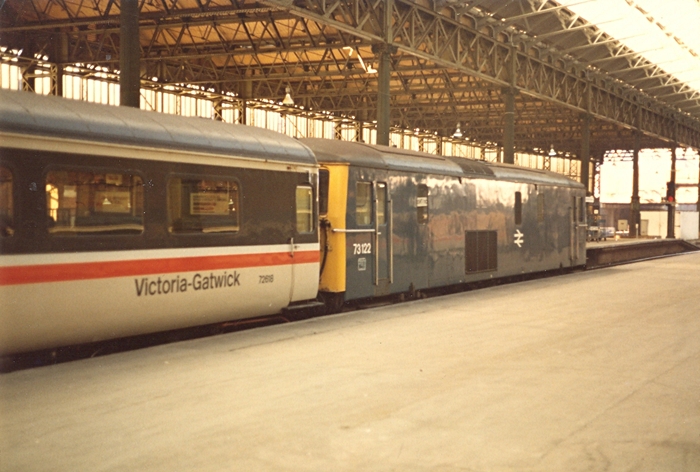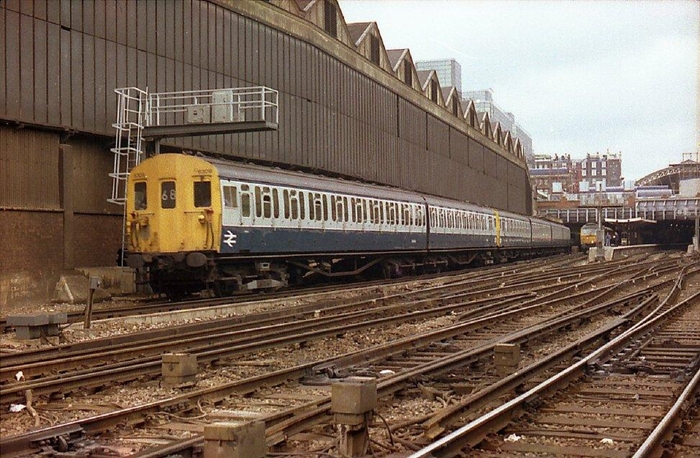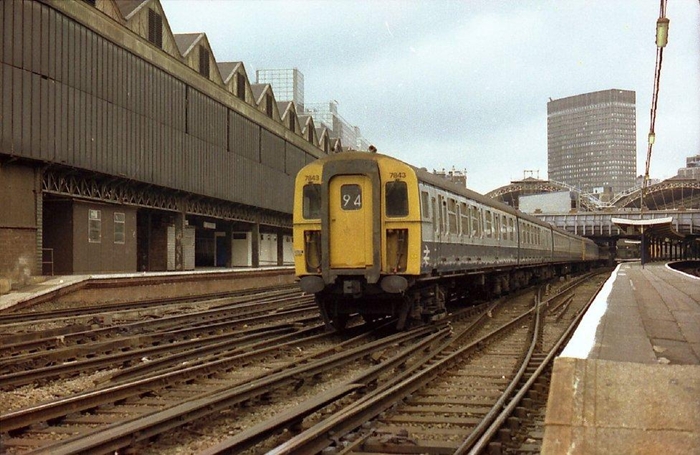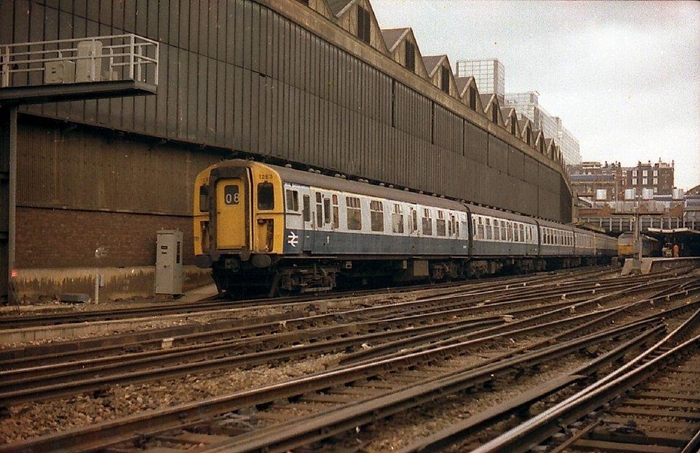
London Victoria
An Overnight Stay: Grosvenor Hotel
As earlier mentioned, a year and a half separated the opening of ‘’Brighton’’
and ‘’Chatham’’ stations, and during the interim, construction of a hotel,
intended for railway passengers, was undertaken. This was a separate venture,
completely independent of the railway companies, and saw the erection of a
colossus of a building on a 75-foot-wide site sandwiched in-between Buckingham
Palace Road and the western elevation of the ‘’Brighton’’ station. Construction
formally began on 13th April 1860. The structure was designed by James Thomas
Knowles, in sympathy with existing buildings in the area, and building work was
subcontracted to Mr Kelk (of whom was also responsible for the ‘’Brighton’’
station). Italianate in style, the building rose up eight storeys to a height of
150-feet, was topped off with a French Renaissance-style roof, and extended down
the side of the station for 262-feet. Suffolk White Brickwork was used
throughout in construction, and this in turn was frescoed externally with stone
carvings, semi-circular-shaped windows, and iron railings. On entry, customers
were immediately presented with a spacious and elaborately decorated foyer,
which contained a symmetrical staircase leading to all eight floors. To the
relief of those staying on the upper floors, a hydraulic-powered caged lift was
available, which was 8-foot square. The hydraulic system was installed by
contractors Messrs. Euston and Amos, and the lift was capable of taking ten
people at a time.
The hotel comprised 300 rooms, and there was a direct entrance to the building
from the ‘’Brighton’’ station concourse. The hotel agreed to pay a sum to the
LB&SCR for every passenger which used the concourse entrance. Within the
building were 1500-feet of narrow stone corridors, and an interesting range of
communal rooms:
Coffee Room
Ladies’ Coffee Room
Dining Rooms
Smoking Rooms
It was noted at the
time that a common feature the hotel lacked was a billiard room, but that the
smoking room was one of the finest ever seen. The hotel formally opened its
doors on 14th April 1862.
Independence and Connections with the Great Western
1860 had been an important year for the LC&DR, and not just because of the
commencement of through running between the capital and Canterbury. The company
had also seen the ‘’Metropolitan Extension Act’’ pass successfully through
Parliament, which held the key to independent access to Victoria. The Act
authorised a completely new route between Beckenham and Battersea via Herne
Hill, and its advantages were two-fold: not only would the line allow the LC&DR
to avoid costly track access payments to the LB&SCR, but it also gave rise to a
new double-track spur to the City of London. For 2½-years, the LC&DR was subject
to LB&SCR tolls over those metals originally opened under WEL&CPR auspices. This
eventually came to an end in 1863 when, on 1st July of that year, the avoiding
line via Herne Hill came into regular use. This had opened piecemeal:
Stewarts Lane to Herne Hill: 25th August 1862
Herne Hill to Beckenham: 1st July 1863
Full opening of the
line had been delayed by the Board of Trade, which decreed that spikes in the
permanent way had to be replaced by wooden trenails. It was followed on 1st
September by the LC&DR taking over the lease of the Mid-Kent Railway, which had
previously been assigned to the SER. The double-track spur to Blackfriars came
into use later, on 1st June 1864. Even the LB&SCR abandoned much of the original
WEL&CPR line, save for local services, when it commissioned a shortened route
between Balham and East Croydon on 1st December 1862.
The GWR’s existence at Victoria lasted for a fifty-two year period, ending in
the midst of the Great War. The company paid the VS&PR a sum of £1,500 in 1860
(about £110,000 at 2007 prices) to compensate for the additional works required
to lay Broad Gauge track. The GWR’s decision to operate a proportion of their
services from Victoria derived from the potential revenue generated from the
West End, an area from which Paddington was remote. One criticism of Paddington
was that it was cut off from the City of London and the Houses of Parliament,
thus the opportunity to operate into Victoria was one not to be missed. The
company was also keen to highlight the useful through line connections with the
Brighton and Dover routes, indicating the future importance of these for the
conveyance of continental and general traffic between the railway systems.
The GWR was to reach Victoria by means of the ‘’West London Extension Railway’’,
a joint undertaking between the LNWR, GWR, LB&SCR, and LSWR. The line formed a
junction with the West London Line at Wormwood Scrubs, and took a course through
Kensington, before being taken over the Thames upon Battersea Railway Bridge
(or, alternatively, ‘’Cremorne Bridge’’). The latter was a product of the LNWR,
designed under the guidance of the company’s Engineer in Chief, William Baker.
The bridge accommodated a double-track and sported five wrought-iron arches,
each spanning 120-feet. Finally, on the south side of the Thames, the line
joined the networks of the LSWR and LB&SCR in Battersea, at what became known as
‘’Falcon Lane Junction’’. This was where the Richmond branch joined the LSWR
main line, the latter of which ran alongside the LB&SCR’s line to Victoria.
The ‘’West London Extension Act’’ emerged in 1859, and the ‘’West London
Extension Railway Bill’’ passed through Parliament on Thursday 1st August 1861,
after a third reading. The line was seen as being of great importance, for it
formed the first metropolitan junction between the main lines north and south of
the Thames, on the west side of London. On Tuesday 20th August 1861, it was
reported in ‘’The Times’’ that ‘’Every exertion is being used to ensure the
opening of the West London Extension Railway for the traffic of the
International Exhibition of 1862’’. Also stated was that ‘’the works of the West
London Extension Railway and of the Victoria Station in Pimlico have been
carried on with considerable spirit, and it is believed that both will be ready
for opening early in the summer’’ and the ‘’junction with the West London
Railway at Wormwood Scrubs is advancing satisfactorily’’. The opening of the
West London Extension Railway did not occur until 3rd March 1863, and at the
time, it was reported that the line was of peculiar background – the company
name under which it was promoted had no shareholders, capital instead coming
from the aforementioned group of railway companies.
A Victoria to Southall GWR Broad Gauge service commenced on Wednesday 1st April
1863. Trains called at Hanwell, Ealing, Kensington, Chelsea, and Battersea,
which, according to the GWR, afforded ‘’direct communication between all
stations on the Great Western Railway and stations on the London Chatham &
Dover, and London Brighton & South Coast Railway.’’
GWR Departures: June 1863
7:50 AM Victoria to Southall (running in connection with the 7:30 AM Third Class departure from Paddington)
9:48 AM Victoria to Southall (retimed from 9.55 AM)
10:45 AM Victoria to Windsor
8:35 PM Victoria to Windsor
GWR Arrivals: June 1863
7:55 AM Southall to Victoria
9:10 AM Southall to Victoria
11:55 AM Southall to Victoria (retimed from 12:15 PM)
12:00 PM Reading to Victoria
12:30 PM Windsor to Victoria
February 1875 was a time of cutbacks. In the previous month, J. Grierson, General Manager, Paddington, announced a number of service withdrawals.
GWR Discontinued Departures: February 1875
6:00 AM Victoria to Southall
8:11 AM Victoria to Southall
3.30 PM Victoria to Southall
1:53 PM Southall to Victoria
7.50 PM Southall to Victoria
9.20 PM Southall to Victoria
Conversely, on Saturday 26th June 1897, a considerable service improvement was announced by the GWR, to commence that July.
GWR Departures: July 1897
11: 10 AM Victoria to Windsor (extended from Southall)
12:25 PM Victoria to Southall
1:42 PM Victoria to Southall
3:20 PM Victoria to Southall
4:52 PM Victoria to Windsor (extended from Southall)
6:18 PM Victoria to Windsor (extended from Southall)
8:12 PM Victoria to Southall
GWR Arrivals: July 1897
9:25 AM Windsor to Victoria (extended from Southall)
10:38 AM Southall to Victoria
12:25 PM Southall to Victoria
2:20 PM Southall to Victoria
3:50 PM Windsor to Victoria (extended from Southall)
7.10 PM Southall to Victoria
The LB&SCR station
was not without its ‘’alien’’ traffic, and the LNWR started a Broad Street to
Victoria service on 1st January 1869, using the same West London Line connection
at Clapham Junction as GWR trains. From 1st February 1872, the Broad Street
service ceased, but was replaced by another train only emanating from as far as
Willesden Junction.
In the meantime, the ‘’Chatham’’ station had amassed a collection of services
originating from ‘’foreign’’ territory, of which those of the GWR have already
been mentioned. The LC&DR had maintained a physical connection with the metals
of the Metropolitan Railway since the completion of the former’s Metropolitan
Extension through Ludgate Hill, on 1st January 1866. The Great Northern Railway
had contributed £320,000 (about £21,872,310 at 2008 prices) to the construction
cost of this line from Herne Hill to West Street Junction (where the route
connected with the metals of the Metropolitan Railway), and in return, the
company was granted running powers. On 1st March 1868, the GNR began running
between Barnet and Victoria via Loughborough Junction, an operation which was to
last nearly forty years. This service was joined in the following year by the
trains of the Midland Railway, which ran through between Victoria and
Hendon/South Tottenham from 1st July 1875. On the same date, the LC&DR also
commenced its own service to Hendon – six years previously, the company had
started a Victoria to Finchley Road train.
London Victoria: 2004
London Victoria layout, as of 2004. Click the above for a larger version. Drawn by David Glasspool
9th June 1984

Class 73 No. 73122 is seen fronting the Gatwick Express service at a time when there was no dedicated pool
of locomotives for this working. Much in evidence is the section of LB&SCR trainshed which was situated
in-between Ecclestone and Elizabeth Bridges. © David Glasspool Collection
May 1985

2 EPB No. 6309 leads out a 4 EPB unit from the Central Section's platform 9, on a service to Purley. Alongside
can just be seen Class 47 No. 47513 ''Severn'', fronting a British Pullman service to Aintree, for the Grand
National. © John Horton
May 1985

An Eastern Section service this time, with 4-VEP No. 7843 departing platform 5 with the 09:12 Margate via
Ashford working. As can be seen in both this and the previous photograph, the northern halves of the Central
Section platforms have already been built on, but the trainshed south of Ecclestone Bridge was still standing.
© John Horton
May 1985

An 8 CIG formation, headed by 4 CIG No. 1263, departs Victoria's platform 9 with a service to Littlehampton.
In the background can be seen the rear of the 1908-opened Grosvenor Hotel extension. © John Horton
<< Previous Next: The History Continues >>
Return to the Kent Rail Homepage or alternatively, check for Updates.
Website & Copyright information - Links - Contact the Webmaster
All content is copyright © David Glasspool unless otherwise stated